I Ain’t Talkin’ Bout No Empire, I’m Talkin’ Bout a (Paradise) Dynasty
I’ve said it once countless times and’ll say it again, Fridays in Hong Kong are sacred for this Big Body. In such a cold world, real cold world, it’s incumbent on oneself to do what you know makes you happy while minimizing the things that ultimately cause you internal vexation and strife.
Staring down the face of an unrecognizable man while pensively (yet thoroughly) brushing your teeth come Monday morning isn’t a great feeling, especially knowing you spent the previous several days deep in the throes of indulgent, ephemeral experiences, vices, and relationships.
At the ripe old age of 34, I’m getting better at choosing real happiness instead of the illusion of real happiness. For me, it starts with “Friday hangs” with my Farjar, aka my Fahza, aka (aka) my father. “Fahza Fridays.”
Recently, we switched things up from our usual stomping grounds of Tseung Kwan O (TKO) and ventured out to the now elephant graveyard of one of the most iconic and technically demanding airports in the world – Kai Tak Airport. As of 2024, Kai Tak is (essentially) a dusty sandlot of former glory undergoing ambitious governmental redevelopment efforts, taking a similar shape to many previous cultural centers and their not-so-pernicious shedding of Hong Kong’s heritage.
That’s right. It has its own 1.9 million square foot mixed-use commercial development now. Which is really just a fancy word for a ‘mall’.
So, with a greater plan in mind (revealed in the outro), we ventured to the Singapore-originated, Shanghai-style restaurant chain ‘Paradise Dynasty’ to gauge its worthiness of being in the conversation with the likes of the early 2000s to late-2010s New England Patriots, Florentine bourgeois Medici family, drunk Big Body Connect 4 chronicles, and other celebrated, historic dynasties of the world.
Here’s why it should be on your radar.
Two Tickets to Paradise (Dynasty)
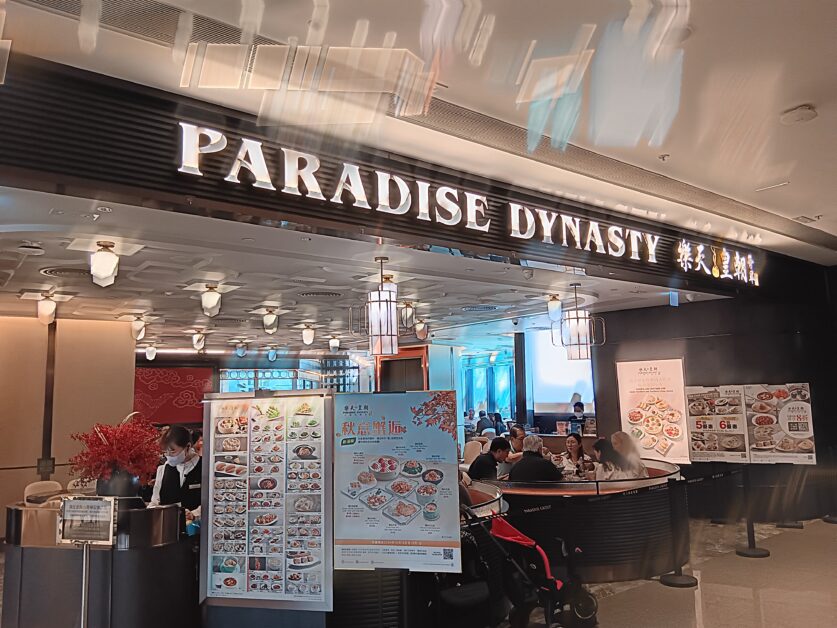
Website, Address, & Details: https://www.paradisegp.com/paradise-dynasty/
- Location: Shop 418, 4/F, Airside, 2 Concorde Road, Kai Tak, San Po Kong
- Price: $-$$ – Paradise Dynasty is on the more reasonable side for the quality of food, variety of dishes on the menu, and service. The total bill for roughly 7 dishes and several rounds of iced lemon tea came out to just over HK$700.
Pale Ale Travel Note: There are 6-7 other locations spread across every pocket of Hong Kong, which you can peep here.
As someone who spent his high school days aimlessly wandering the dimly lit corridors of Newington, New Hampshire’s Fox Run Mall, stopping occasionally to spend whatever money his mother had given him at Sbarro or Orange Julius, malls have come a long way from what I remember.
The only Asian restaurant we had in our one-story mall with JCPenney and Sears outlets on the perimeter was a Japanese teppanyaki spot that I’m about 99% sure they would sneak in a Latino or two to try and pass off as a born and bred-chef from the Land of the Rising Sun.
So, although Kai Tak may or may not be evolving into another cookie-cutter symbol and mecca of consumeristic tribalism that many would argue the city doesn’t need more of (myself included), I have a soft spot for one-stop shops that offer up more than just Hot Topic, Journey’s, and Kay Jewelers kiosks.
Enter Airside. All 1.5 million square feet of it.
Once on the fourth floor of the Airside’s mall, Paradise Dynasty is easily recognizable thanks to its illuminated block lettering that beckons you like a gingerbread, cake, and sugar-covered cottage deep in a German forest. However, it’s multicolor xiaolongbao, spicy noodle dishes, and scallion pancakes that await you instead of crab shells.
Better yet, a decrepit blind witch doesn’t plan to eat you after you fatten up.
Pale Ale Travel Tip: One of my absolute favorite spots for roast goose and char siu in the city is at Kam’s. However, the main Wan Chai location always has a longer wait than I’d like. So, here’s my cheat code. Head to the South China Athletic Association to enjoy this traditional Cantonese food without the wait at their bowling alley location. Here’s everything you need to know about Kam’s.
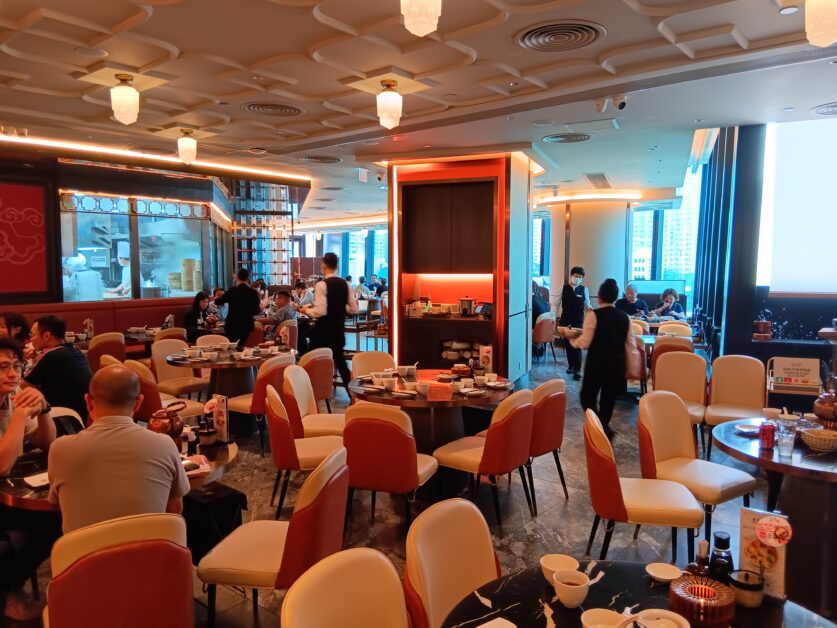
The restaurant’s interior is as most traditional banquet-style dim sum and Shanghai restaurants are, elegant but functional, with generously spaced hallmark round tables for communal dining, subdued lighting, and red, white, and lacquered Chinese motifs scattered across the walls.
A transparent glass portal to the back left allows diners a look into the workings of Paradise Dynasty’s industrious chefs – who sport tall white hats while stir-frying classic Chinese and Cantonese fare, weaving in and out of columns of bamboo dim sum baskets and dissipating clouds of steam.
It has all the telltale signs of a restaurant that knows what it’s doing. But does Paradise Dynasty write aesthetic checks that its fare can’t substantively cash? Let’s have a look.
Pale Ale Travel Tip: ‘Fahza Fridays’ are what I call the bi-monthly days of the week where I meet my father to catch up over a bite of whatever we’re feeling. Make sure to check out my posts breaking down several of my favorites, which include our day out at The China Club and my low-key favorite restaurant in all of Hong Kong – Hygge.
A Spread Fit For the Early 80s Boston Celtics
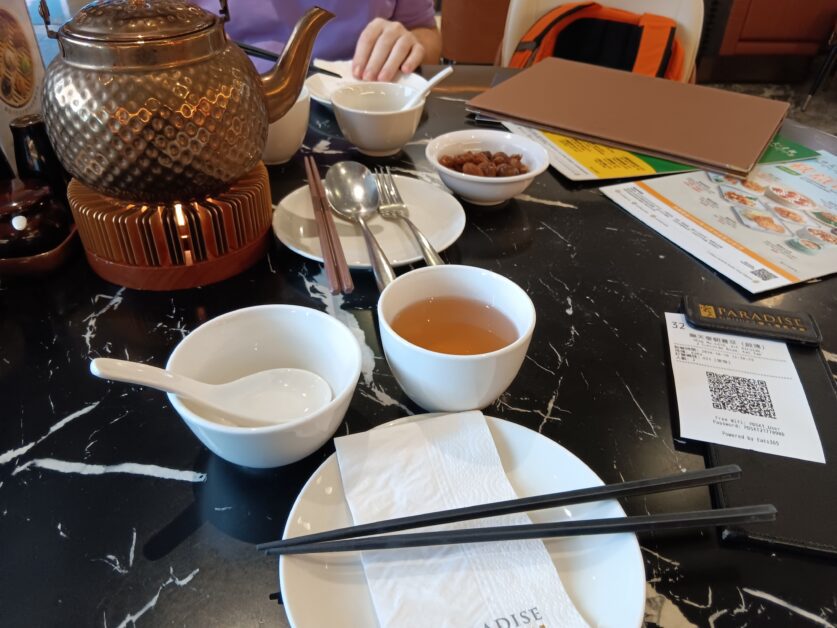
The title of this section is, of course, a very esoteric reference to the Larry Bird days of basketball and the basketball dynasty he helped cultivate on the East Coast.
Sometimes, like the beloved, illiterate janitor from It’s Always Sunny in Philadelphia, the words just get caught in my mouth and I don’t say ‘em no good. So, I think I just have to lift Paradise Dynasty’s description of itself from its website.
“Paradise Dynasty promises you a gastronomic journey through dynasties of China, with northern and southern Chinese cuisine across generations.”
As mentioned in the introduction, it’s a Shanghai-style restaurant under the ‘Paradise Group’, a Singapore-established restaurant group with twelve different cuisine concepts (primarily tracing northern and southern China) and 150-plus restaurants worldwide.
More of an empire rather than a dynasty some might say but who’s here for my smug nonsensical semantics?
Since my Fahza and I QR code-ordered so many dishes, I’m going to break things down into Cold Stone Creamery terms and lay out exactly what you’ll like, love, and ‘gotta have’.
Like It
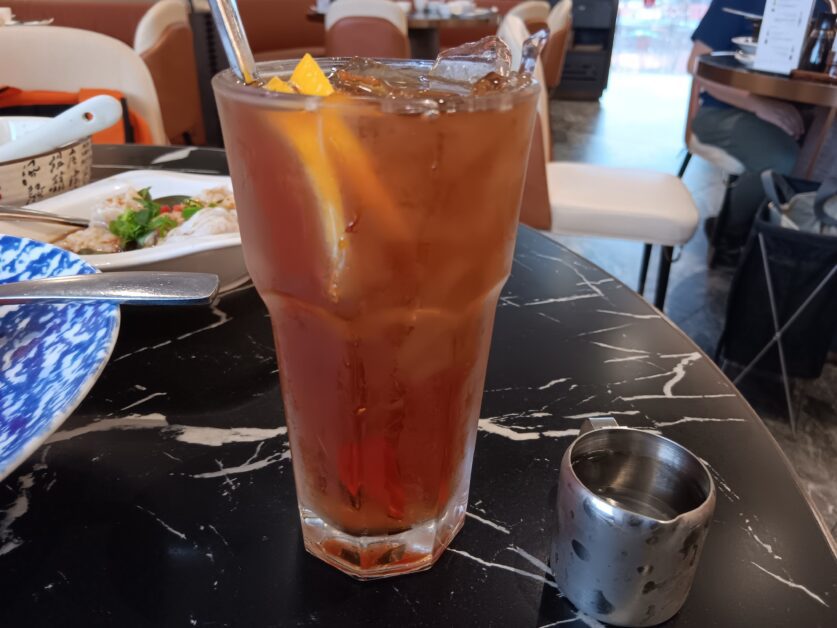
If you don’t order a quintessential Hong Kong iced lemon tea to wash it all down (or three of them), you’re doing it wrong.
I’m using Cold Stone Creamery vernacular to rank the dishes at Paradise Dynasty because, as I’ve mentioned before, I’d never write about an establishment I didn’t wholeheartedly recommend.
So, while several dishes weren’t my favorite, overall, Paradise Dynasty knows what they are doing and can play for me any day of the week.
I’d never be unhappy (or hungry) after returning here.
Multicolor Xiaolongbao

“A jack of all trades but master of none” would be how I describe the ‘Eight flavor specialty xiao long bao’ at Paradise Dynasty. Like that man or woman you saw on Bumble who, on paper, ticks every box you’re looking for, it fails to live up to the in-person portion of the date. There’s still some hidden excellence and redeeming qualities but the totality of it just fails to pack a memorable gastronomic punch and outweigh the gimmicky nature of it.
I enjoy that they provide you with your own little color reference chart to easily identify which is which.

With eight distinct flavors in a single basket, you have to be comfortable with the person you’re dining with to not resent them after you enter into a heated negotiation with inevitable concessions on several flavors.
For me, I definitely lost on the Szechuan flavor front (the molten lava red xiaolongbao you see above) but won on the foie gras and black truffle. I’m also undecided if I came out on top or at the bottom when it came to the luffa gourd, aka Chinese okra.
The biggest difference between Paradise Dynasty’s xiaolongbao and what I look for in an exceptional soup dumpling is the holy triumvirate of balance, high-quality ingredients, and technique. Forget the dance move created by early-1970s Los Angeles gang members. I’m all about that ‘Crimp walk’ rather than the ‘Crip walk’.
Paradise Dynasty’s xiaolongbao dough wrapper was just slightly too thick, which ultimately resulted in a stickier casing that didn’t quite let some of the milder dumpling amalgams and their flavor profiles come through – specifically the cheese and garlic. However, more pronounced flavors like the foie gras, crab roe, and Szechuan (the latter of which my father had) didn’t suffer from such a fate thanks to their natural savoriness and spiciness (I hate to use the word ‘umami’).
For my Fahza, who I graced with the control xiaolongbao (the original), this meant that the minced pork and its rendered gelatin-rich broth took a back seat, which should never be the case. Further, the pork just was a bit too springy in texture, which I’m guessing to be a slightly “off” ratio of lean meat and fat. Across the board, there was also a glaring lack of broth. Any xiaolongbao that I can confidently eat without worrying about third-degree burns on my chin just isn’t up to the standard it should be.
Comparison is the thief of joy and I’m afraid several exceptional xiaolongbao bites as of recent have this Big Body opining from his ivory tower. But for Din Tai Fung’s truffle and Kurobuta pork xiaolongbao, I truly believe that xiaolongbao embodies the mantra “If it ain’t broke, don’t fix it,” down to a T.
Pale Ale Travel Tip: Curious about tipping culture in Hong Kong? Make sure to check out my post breaking down the situations when you should and shouldn’t tip in Hong Kong.
Dan Dan Noodles With Dumplings
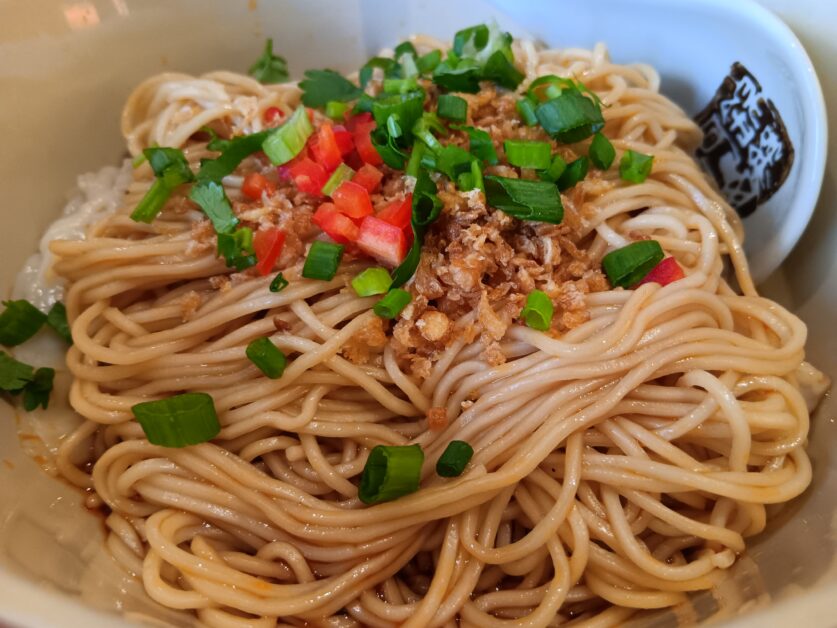
I’d say in all of my Chinese cuisine Rolodex, next to scallion pancakes and xiaolongbao, dan dan noodles (aka ‘dan dan mian’) is the food I’ve eaten the most of in my decade-plus Asia tenure. Something about a numbing minced pork ‘meat sauce’, scallions, chili oil, and pickled vegetables over springy noodles just gels with every ounce of my being.
What’s funny is I’m not even particularly someone who craves spice. But the chili oil used in dan dan mian packs that mala (numbing) taste that is addictive and gustatorily recoverable from, meaning your whole mouth isn’t singed and unable to differentiate flavors for subsequent days or weeks to come like say a habanero-infused dish.
For reference, ‘mala’ is a spicy seasoning made from Sichuan peppercorn and chili. Imagine dipping your tongue in delicious, mildly sour battery acid and then it’s supercharged with the electric shock device used to torture shirtless Mel Gibson in Lethal Weapon. I say that in the best way possible.
We stayed true to the original dan dan mian, which in its ancestral home of Sichuan takes a soupless form. It really only was in Hong Kong that the dan dan mian with broth took flight. However, brothy dan dan mian is now ubiquitous across Mainland China, with Sichuan remaining as one of the last bastions of dry noodles.
Overall, Paradise Dynasty’s dan dan mian was just slightly too incohesive. Each layer really exercised whatever dumpling equivalent of self-determination there is and stood independent of one another, never quite harmoniously infusing together. Simply put, I had a lot of great bites of springy noodles, I had a lot of great bites of well-seasoned minced pork, and I had a lot of good hits of chili oil. But I never quite had all three at the same time.
The prawn and Kurobuta pork dumplings, however, were the perfect vessels for the chili oil, which did permeate their glossy interior and yielded a more balanced bite. That brings me to the ‘Love It’ portion of this broadcast.
Pale Ale Travel Tip: Let’s switch things up for a second by turning to Japanese noodles. After my 3 months in Osaka, I can’t get enough of them. So, I carved through some of Central Hong Kong’s top spots to see what they were about. Make sure to check out my post breaking down my top ramen restaurants in Hong Kong.
Love It
This is where Paradise Dynasty powered things into the next gear and started rolling out early-2000s banger equivalents of bites that you can blast on repeat all day.
Oops, they did it again with these morsels that are beautiful, no matter what others say, so just accept that you’re crazy in love with them like this hollaback Big Body did.
Prawn & Kurobuta Pork Wontons (Spicy)

If you don’t know ‘Kurobuta pork’, you should. I wrote of its somewhat funny origin in great detail in this post breaking down my absolute favorite ramen joint in all of Japan – Taiho Ramen. The TL;DR is that some call it the ‘Kobe beef’ of pork due to the high percentage of intramuscular fat in each bite. Simply put, that just means it’s extremely juicy and tender.
While the English translation on the Paradise Dynasty menu refers to these as ‘dumplings’, there’s a little nuance that’s important to establish. They are wontons, a subset of the all-encompassing term ‘dumplings. The Chinese name for the dish on the menu is ‘红油鲜虾黑豚肉抄手, the bolded characters translating to chili oil hand-folded dumplings, aka wontons.
Wontons are made with square wrappers that are folded at two specific points and then cooked in a broth and/or soup base while ‘traditional dumplings’ (you can, of course, fry wontons as well) are made with circular wrappers and usually ‘crimped’. In general, wonton wrappers are thinner and typically only filled with meat.
In my opinion, the texture of a wonton is more reminiscent of ‘cheung fun’ thanks to its slippery, often “wetter” texture. It’s also one of those dishes that frequently reminds me that after all these years I’m still comparatively horrible at using chopsticks.
These more than pass wonton muster. Unlike Paradise Dynasty’s dan dan mian, the mala adequately imbues the translucent miniature asteroids of fatty pork and slightly sweet prawn with a scintillating numbing spice that will pop, lock, and drop all over your tongue.
Topped with both crunchy chives and a small dousing of the familiar (lighter) meat sauce you’d encounter over your dan dan mian, there’s a complexity to what otherwise might first come across as a straightforward classic.
Crispy Prawn Spring Roll
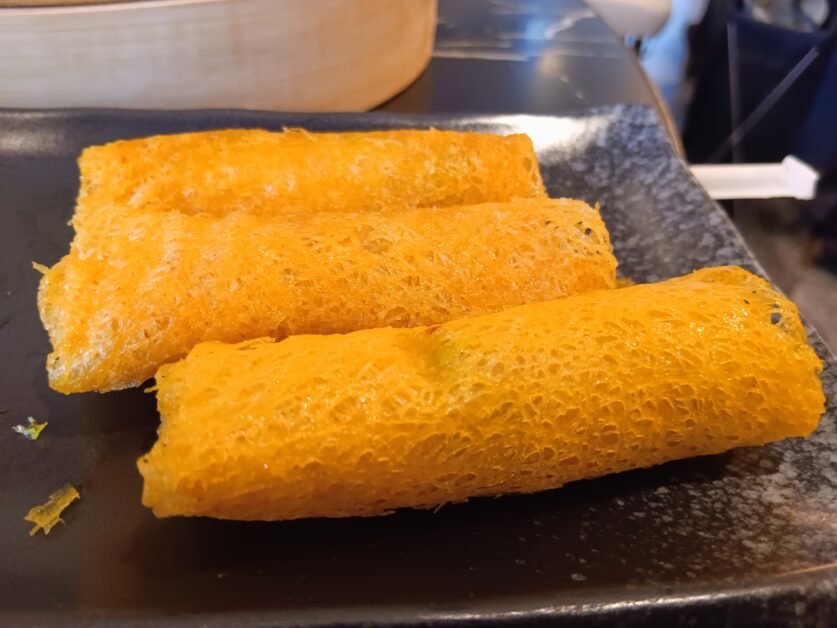
Unlike thicker, denser spring rolls that you might encounter at a Chinese restaurant in the West or even a Filipino lumpia, the crispy prawn spring rolls at Paradise Dynasty were delicate and airy in texture. Zero grease. I suspect it is thanks to an almost translucent wrapper that was used.
This allowed the natural sweetness and slight brininess of the tender prawns to stand out while providing a welcomed textural contrast. Rather than frying up a spring roll for the sake of simply filling you up, there was a deliberate choice to showcase the filling – something I find to be a rarity in this cutthroat spring roll game.
Gotta Have It
Below are the dishes that I’m currently undergoing withdrawals from. So if you see me frantically pacing back and forth in the back alley behind Pure Kinwick Center, help a guy get his fix and toss him some spare wood-ear fungus you have on you.
Pan-Fried Scallion Pancakes
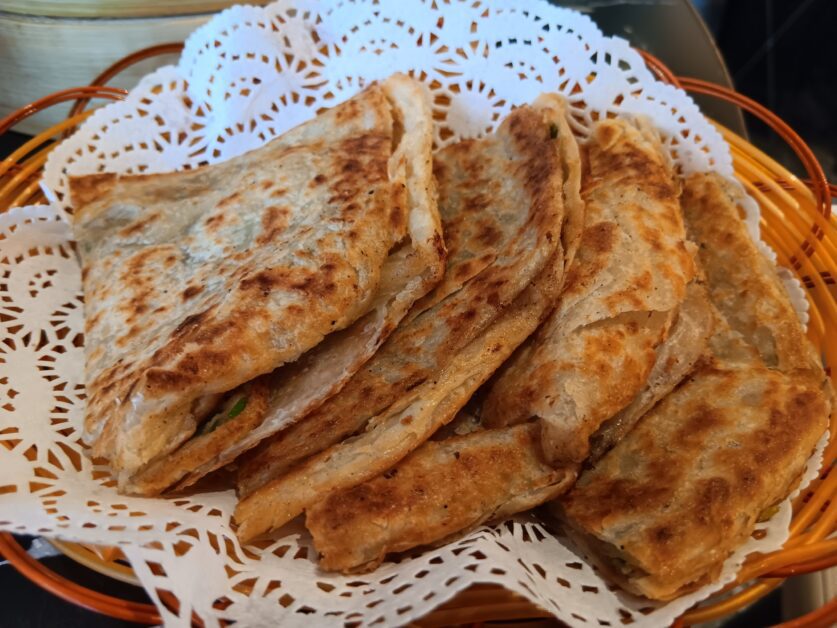
When I say that I haven’t eaten a scallion pancake better than those pictured above, I just simply ain’t playing.
With the seemingly never-ending geopolitical tensions that exist between both regions (amongst many others in the world), I don’t want to incite any sort of further discord but there’s a thickness to these bad boys that heavily resembles an Indian paratha.
Both are unleavened flatbreads that are folded and layered on top of themselves. However, Indian parathas opt for whole wheat flour over all-purpose flour (traditionally used in scallion pancakes).
If you wanted to take the entire meal we had and turn it into your own persona ‘kati roll’, you could thanks to it being sturdy, pliable, and fluffy at the same time.
Where I think scallion pancakes excel and outshine the Indian paratha is in their ability to hone in on a true crispy exterior which gives way to a soft, layered interior that dissolves in your mouth. The moderate gluten content of all-purpose flour protects against a layered texture that becomes overly chewy or dense, allowing for more distinct, flakier layers.
Like clockwork, I typically dunk my scallion pancakes into whatever noodle or soup broth I have as I always find them to be just a tad dry and too much to take down without a little added flavor. That didn’t even cross my mind with these.
Served warm and accentuated by a subtle aromatic onion flavor of the scallions and the “fattiness” of the oil that’s layered into the dough during preparation, “savory” would be an understatement to describe this dish.
Black Fungus in Peppercorn Vinaigrette
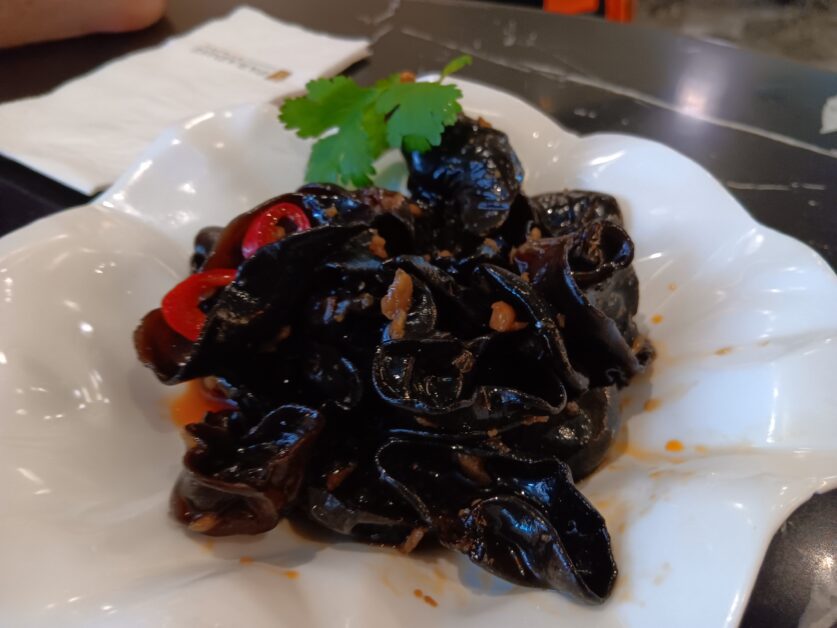
Next to the scallion pancakes, Paradise Dynasty’s black fungus in a Sichuan peppercorn vinaigrette stole the show for Big Body.
Also known as ‘wood-ear mushrooms’, this dish is one that I never think to order but it’s a favorite of my Fahza’s, and boy, am I glad that I brought him along.
It’s tangy, earthy, spicy, and crunchy. It’s served cold. It’s a texture that takes on several profiles due to its somewhat slippery ‘leafy petal’ base. However, upon biting into each velvety ‘ear’, there’s a distinct (audible) crunch that reminds you of a hybrid between dried mango and a Cape Cod potato chip.
Much like its texture, the dish’s flavor profile is surprisingly more complex than you might first assume. The slightly numbing, mouth-tingling quality of the Sichuan peppercorn, paired with the sharp (but not overly pungent) dousing of vinegar helps draw out some of the subtle taste of the black fungus.
However, there’s no worry of any sort of overwhelming earthy fungus flavor like say a ‘porcini mushroom’ (or even shiitake) thanks to an already mild flavor that is cut through even more by the vinegar (often with a hint of sugar) and its acidity.
I’m not sure how many dishes with noticeable spice I’ve ever referred to as ‘refreshing’ in my life but such a term would be appropriate in this case.
Sweet & Sour Fish
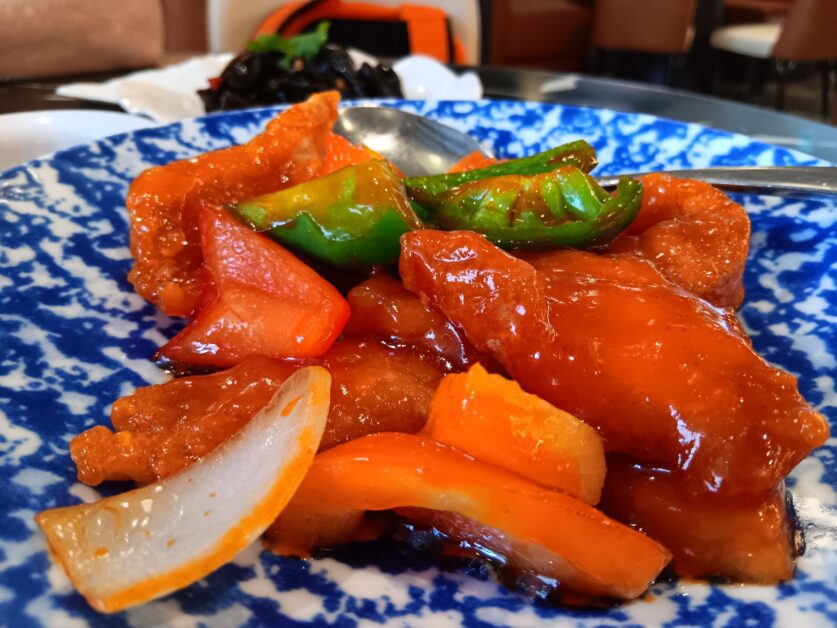
In a world of sweet and sour chicken and sweet and sour pork, a dish that gets entirely overlooked is its seafood counterpart – sweet and sour fish.
This is just good ol’ Chinese comfort food at its finest. There’s nothing overly sexy about a dish that utilizes a ketchup-driven sauce infused with sweet chili, vinegar, and sugar. But it’s nostalgic, it’s glossy, and it’s delicious.
A mild-flavored white fish, typically sea bass or tilapia is used and coated in a light batter. This is then deep-fried until golden and crispy. From there, a sticky, sweet and sour sauce is concocted (out of the aforementioned ingredients), which then liberally coats the golden, crispy fish.
What ends up in front of you is probably similar to what the first contestants on Pimp My Ride saw after X to the Z, Xzibit came bouncing out (on 20s) in their new, souped-up, repainted ride – a colorful, glossy, sensory overload.
However, unlike your ‘98 Corolla that’s still internally hanging on by a thread and is set to smoke out on the 405 just several days later, there’s more than just a shiny veneer to Paradise Dynasty’s sweet and sour fish. There’s substance behind the hood.
The fish is firm yet tender and avoids buckling under itself due to sogginess or overcooking. The medley of vegetables, specifically pineapple, peppers, and onions draw out further sweetness of the dish and provide extra textural crunch to the crisp fish. The sauce hits you with a tang that will have you ready to launch into orbit…like in those Tang commercials from your childhood.
It shouldn’t be this balanced but it is – while I’m walkin’ like a Jabberwocky to scalp a pair of one-way tickets to shadowboxing.
Note: I’m about 99% sure because of the addition of ketchup to the sauce that this is classified more as traditional ‘Cantonese-style sweet and sour fish’ rather than that of the Mainland.
A Slice of Kai Tak Paradise For You & Your Dynasty
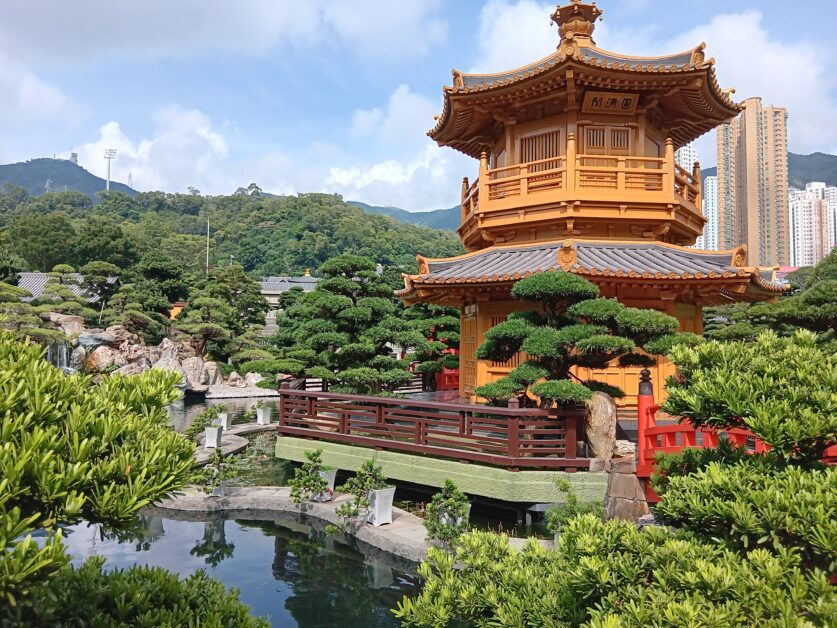
I can confirm that The Pavilion of Absolute Perfection in the Nan Lian Garden is accurately named. I mean, look at it.
Is Paradise Dynasty the greatest Chinese restaurant that I’ve ever eaten at? No. But is it a formidable candidate for getting your noodle, wonton, sweet and sour fish, and lotus ear fix? Absolutely. Is it even better to pair it with a trip to the Chi Lin Nunnery and Nan Lian Garden in Diamond Hill right after? Now we’re talkin’.
Next to spending roughly 10 days with my brother in Poland, this was one of the most memorable days of 2024.
It’s restaurants like Paradise Dynasty that make you think of the term ‘restaurant chain’ differently. It’s almost an insult to refer to it as such as I imagine the term conjures up images of TGI Fridays, Olive Garden, and Panera. There’s authenticity and refinement to this place. And when you sprinkle on adherence to tradition on top of that, you have a restaurant that isn’t just repeatable but craved and proactively offered up amongst your group of ride-or-dies.
Side note: I’m still not over the TGI Friday’s waitress who spilled a container of bleu cheese on my head when I was 12.
If you have any questions about eating or drinking in Hong Kong, please don’t hesitate to reach out to me at info@palealetravel.com. Also, please let me know in the comments how much sugar you pour into your iced lemon tea.
At the moment, due to an influx of inquiries/messages, I’m prioritizing responses for those who are subscribed to my newsletter, so please make sure to include the word ‘Subscriber’ in your email.
Eat well everyone,
Big Body
Big Body is a voracious lov…eater, a cowardly fighter, and a self-proclaimed curry goat BBQ-eating champion (don’t forget the donkey milk) who likes Stoicism, baseball, and writing in the third person. Having worked for himself for the last 7 years, he isn’t particularly successful but he does still drink ice-cold Sapporo draft beers with the best of them and knows his way around a Dai Pai Dong or two. He is based in Hong Kong but you can still find him in Saigon, Osaka, and Vienna for extended periods.
